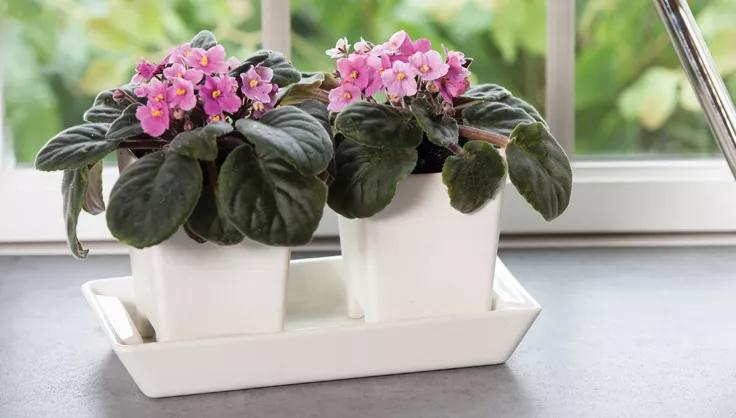How to Grow & Care for African Violets
African violets have been popular houseplants for nearly 100 years, and with good reason. With the right care, many plants can bloom nonstop. And, compared to some flowering houseplants, violets are perfect for beginners, but offer enough variety to keep even green-thumb experts intrigued.
Choosing an African Violet
Choosing just one plant from a big, colorful display is like picking just one jelly bean from the bowl. The range of colors, sizes and leaf forms can be dazzling. Most African violets naturally form a rosette of leaves around one central stem. Some unusual varieties develop multiple trailing stems. Both forms grow in a range of sizes from miniatures less than 3" in diameter to plants as large as a serving platter.
Leaf and flower shapes, colors and sizes vary widely. The hairy leaves may be round, pointed, ruffled, quilted or smooth. Some show white or pink variegation and can be light green to purple underneath. Flowers are even more varied and come in colors from white to pink and purple, blue, green, yellow and even gold. They may be streaked, spotted, splashed or edged in multiple colors. Flower forms range from huge, ruffled doubles to flat singles, sweet bell shapes and every shape in between.
The selection at local shops may be limited to the more common types, but you will find many more choices available from specialists. African violets are so popular that many regions have membership clubs and shows. Find local clubs, breeders and events through the African Violet Society of America
When picking out a plant to take home, look for symmetrical shape, firm green leaves, and lots of flower buds. Avoid plants with soft, droopy leaves and those with brown spots or pests. Plants with a few open flowers and many closed buds will remain in bloom longer after you buy it. Tip: peek under the upper leaves to look for newly forming flower stems.
 If you don't have a sunny location, grow African violets under grow lights, such as in this Bamboo Home LED Grow Light Garden
If you don't have a sunny location, grow African violets under grow lights, such as in this Bamboo Home LED Grow Light GardenWhere to Grow
African violets need bright light to bloom, but cannot tolerate hot, direct sun because their leaves are easily scorched by intense light. Violets bloom best at temperatures from 65 to 75 degrees.
In a sunny window:
In the winter, violets grow best in south-, east- or west-facing windows. On cold winter nights, move the plants away from the glass to a spot that remains above 55 degrees. When the sun gets stronger in the spring, move plants to a cooler east- or even north-facing window.
Tip: give each plant a one-quarter turn clockwise every few days to keep the growth symmetrical.
Under grow lights:
For best flowering and growth, many African violet aficionados grow their plants under grow lights. Set the bulbs about 12" to 15" above the tops of the plants, depending on the strength of the bulbs and size of the plants. Use a timer set to 14 hours of light and 10 hours of dark each day. Tip: African violets must have at least eight hours of darkness daily to produce flowers.
When to water and fertilize
Watering African violets is less complicated than common lore would have it. Follow these simple steps for success:
- Water only when the soil surface feels dry. The pot may feel "light".
- Use room-temperature tap water. Cold water shocks the roots and causes leaf spots.
- Let chlorinated water sit overnight before using
- Avoid softened water, which is too salty.
- Water from the top or bottom, whichever is easier. Soak the soil thoroughly.
- Let the pot drain completely; don't let plants sit in water for more than 30 minutes.
- To avoid spotting, allow wet leaves to dry before putting plants back into a sunny window.
To promote constant flowering, use liquid African violet fertilizer at one-quarter strength every time you water. Once every four to six weeks, flush clear water through the soil to remove accumulated fertilizer salts. If your plant gets dry and wilted, do not fertilize. Rehydrate the plant with water and resume fertilizing once the plant has rebounded.
Potting, Spacing and Troubleshooting
African violets must have potting mix that drains quickly and doesn't hold excessive water. Choose a loose, peat- and perlite-based mix for best results. Tip: Many commercial African violet soil mixes are too dense and heavy for proper root growth.
For best bloom, pots should be about one-third to half the diameter of the plant. For example, a 7-9" plant should be in a 3" pot. A 9-12" plant goes into a 4" pot. Choose shallow pots for best drainage and root aeration. Repot your plant in fresh soil and a clean pot once a year.
Spacing is important. Give your plant enough room so that it doesn't touch its neighbors. Spacing helps prevent pests and diseases from spreading easily, and allows for more uniform growth. To prevent crowding in the pot and keep plants symmetrical, pinch off any suckers or new plantlets that form along the stem.
When buying new plants, check them carefully before purchase. African violets are prone to some common insects and diseases. For very good descriptions and photos of these, visit the African Violet Society of America at avsa.org and click on Violets 101. Follow the links on that page to insects and diseases, as well as other useful tips on caring for your African violet.
Print this Article:
Get the Dirt
Stay up to date on new articles and advice. Please fill out the information below.


